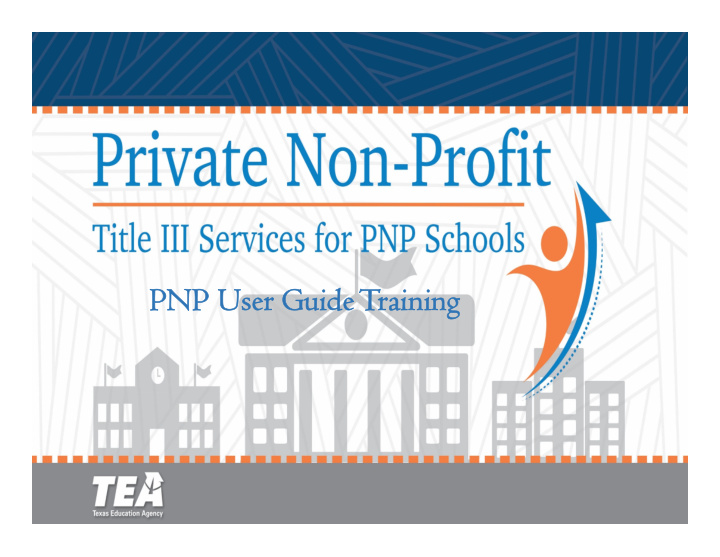



PNP User Guide PNP User Guide Training aining
Objectives AGENDA • Networking Breakfast • Welcome and Introductions • Title III, PNP User Guide Training • Title III, PNP Website and Resources Overview • Title III, PNP Planning Tool • Question and Answer/Closing
Objectives Training Goals • Content Objective • Participants will explore the rules and regulations related to Title III, Part A equitable services to Private Non ‐ Profit (PNP) schools. • Language Objective • Participants will read and collaborate about the procedures for local educational agencies (LEAs) to assist in planning, designing, implementing, and evaluating services related to Title III, Part A services to PNP schools.
Private Non ‐ Profit Title III, Part A Services for PNP Schools Introduction • Title III, Part A Services for PNP Schools details the responsibilities that Title III ‐ funded LEAs have in providing equitable services to eligible PNP schools. Make note : when citing statute the term private school(s) is used. However, at times, private school(s) and PNP school(s) may be used interchangeably. • As part of the Every Student Succeeds Act (ESSA), Title III, Part A equitable services are to be provided to eligible PNP school English learners, their teachers, and other educational personnel. Under Title III, Part A statute, the primary goal is to enable all children attain English proficiency and master standards in academic subjects.
PNP Schools User Guide
PNP Schools Reference Sheet
Title III, Part A: Responsibilities Title III ‐ funded LEAs have a responsibility to provide equitable Title III, Part A services to private non ‐ profit (PNP) schools' eligible English learners with the primary goal of ensuring all students gain English proficiency and master challenging standards in academic subjects. In addition, local educational agencies (LEAs) must follow a process to plan, design, implement, and evaluate their program and services. English Learners and/or Immigrant Students
LEA Four ‐ Step Process The LEA four ‐ step process ensures compliance with federal law regarding Title III, Part A in providing equitable services to eligible English learners in PNP schools.
LEA Four ‐ Step Process Step 1: Annual Contact and Consultation The annual contact begins the consultation process between the LEA and PNP schools located within its attendance boundary. Adequate notice is critical in ensuring a meaningful consultation and the likelihood that those involved will be well prepared with the necessary information and data for decision ‐ making.
LEA Four ‐ Step Process Step 2: Determine Eligibility The LEA is responsible for determining eligibility for the PNP school's English learners. During the consultation, the LEA and PNP school must establish eligibility criteria. The state's policy for identification can be used if agreed upon by LEA and PNP school representatives during the consultation. English learner
LEA Four ‐ Step Process Step 3: Determine and Provide Services The services that the LEA will provide should be discussed during consultation. Services should be designed to meet the educational needs of the PNP school's English learners, teachers of English learners, and other educational personnel. Teacher trainings must be designed to the meet the needs of English learners.
LEA Four ‐ Step Process Step 4: Evaluate Services The LEA is responsible for evaluating Title III, Part A services for PNP schools. The extent of the assessment of services will depend on the size and scope of services provided. Evaluation is a part of the consultation discussion and may include, but is not limited to, services, activities/consultation, and materials/equipment.
Funding • Federal law stipulates the use of Title III, Part A funds and how LEAs can meet compliance. • A service delivery plan must be provided by employees of the LEA or through a contract made by the LEA with a third party (third party contract*) . • TEA requires LEAs with participating PNP schools to complete and submit an equitable services worksheets annually. • In no case are funds actually transferred to participating PNP schools; only services are provided.
Maintaining Documentation Documentation of program activities is critical to ensuring compliance with ESSA, Title III, Part A guidelines. There is: • Required Documentation • Types of Documentation Consolidated Federal Grant Consolidated Compliance Application Report Private Nonprofit School Equitable Services Participation Report Worksheets (Schedule PR7000)
PNP Planning Tool
Texas Gateway www.texasgateway.org )
Resources and Sample Forms Communication log PNP Sample Worksheet for Professional Development Sample formula to PNP School Letter Determine Funding LEA Affirmation of PNP School Letter of Intent Consultation PNP School Inventory LEA Checklist of Sheet Consultation Topics PNP Schools Reference PNP Glossary Sheet PNP Meeting Minutes The Compliance Process Format for PNPs PNP Meeting Sign In Title VIII, Part F – Uniform Provisions PNP Professional Development Sign In
Objectives Training Goals • Content Objective • Participants will explore the rules and regulations related to Title III, Part A equitable services to Private Non ‐ Profit (PNP) schools. • Language Objective • Participants will read and collaborate about the procedures for local educational agencies (LEAs) to assist in planning, designing, implementing, and evaluating services related to Title III, Part A services to PNP schools.
For further information contact your local Educational Service Center.
Recommend
More recommend